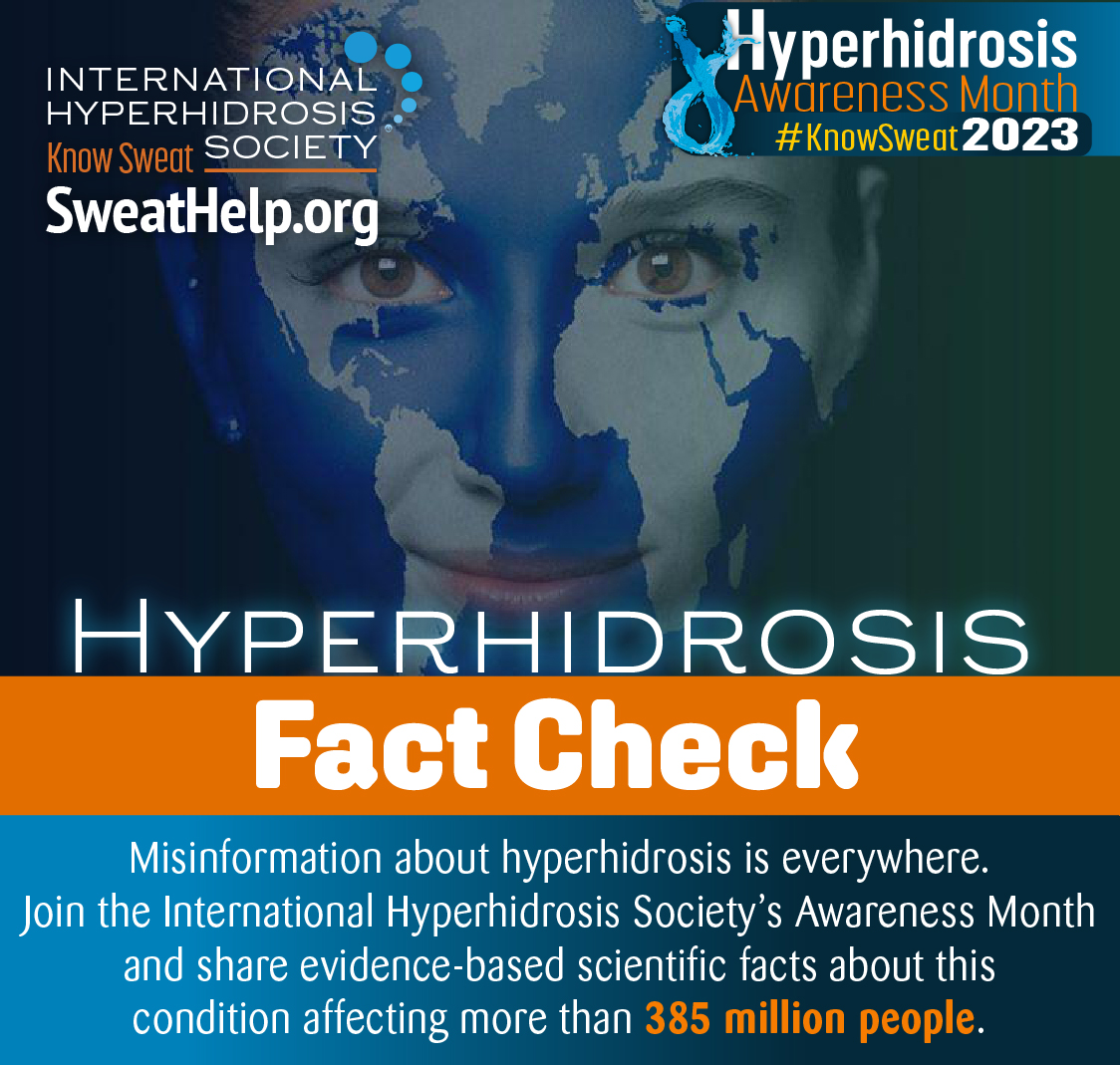

 Fact Check: Hyperhidrosis
Fact Check: Hyperhidrosis
No, hyperhidrosis is not a phase. Yes, it is a big deal. And, no, it's not rare.
We raise awareness of the medical condition hyperhidrosis (uncontrollable, excessive sweating), its impacts, diagnosis and treatment all the time - but for Hyperhidrosis Awareness Month we work even harder! This month, we’re busting common hyperhidrosis myths, misconceptions and misinformation. Please help by sharing this info on your channels!
Myth - You’ll grow out of it
Many well-meaning people, from family members to healthcare providers, often chalk up excessive sweating in young people to changing hormone levels or to a “phase” that will pass with time. Given that the average age of onset for hyperhidrosis is 12 years old, many adolescents experiencing treatable, extreme, uncontrollable, embarrassing sweating can be subject to this “wait and see” mentality. But, according to research, 88% of people with hyperhidrosis say their excessive sweating problem has either stayed the same or gotten worse over time.
Don’t delay. Treatments for people of all ages living with life-altering volumes of sweat are available. Talk to a knowledgeable healthcare provider.
Misconception - It’s just a little sweat, it’s no big deal
Hyperhidrosis is not minor sweating. People with this medical condition will episodically sweat four or five times more than is considered “normal” or expected to control body temperature or as a reaction to stress, activity or excitement. This volume of sweating can noticeably drench clothing and shoes, cause slips, falls and item droppages, drip off hands, elbows and foreheads, and damage objects including technology. And, 20% of people with hyperhidrosis report problems using computers, mobile phones and touch screens.
With most hyperhidrosis sufferers avoiding public view, handshakes and other forms of touch, the social, career and relationship ramifications of hyperhidrosis are often severe. People with hyperhidrosis are more likely to suffer from depression and anxiety (27% and 21% risk for depression and anxiety with hyperhidrosis; 10% and 7.5% without).
Physical impacts are also a concern with hyperhidrosis sufferers having a 300% greater risk of skin infections. The chances of getting eczema (atopic dermatitis) may also increase; and 60% of hyperhidrosis sufferers report negative impacts on their general health and 40% report related physical discomfort.
While severe acne, psoriasis and long-term, extreme itchiness can all be highly detrimental to an individual’s quality of life, research has shown that hyperhidrosis actually results in comparatively bigger quality of life shortfalls.
Fortunately, with today’s treatments, so much of this can be avoided.
Misinformation - Hyperhidrosis is rare
Actually, there are about 385 million people worldwide (based on the most recent populatin numbers) living with excessive, uncontrollable, chronic sweating. That’s about 4.8% of the general population and more than the 1% of people who have natural red hair and 2% who have natural blond hair.
When you look at younger people, the prevalence is even greater with 8.8% of people aged 18-39 years having hyperhidrosis.
Despite how common hyperhidrosis is (more common than autism and psoriasis) about 27% of sufferers are never diagnosed.
This is changeable!
Learn more about the diagnosis of hyperhidrosis and find a healthcare provider who’s in the know.
Fact - Excessive sweating is a treatable skin disease
Hyperhidrosis is a recognized dermatologic condition that can disrupt all aspects of a person's life. But there is support and effective treatment.
Use our website to learn more and stay tuned for more myth-busting and practical information for people with hyperhidrosis and people who care for them.
Huge thank you to our individual donors, miraDry Inc. and Candesant Biomedical for supporting the International Hyperhidrosis Society and 2023 #HyperhidrosisAwarenessMonth!
Get involved on:
Facebook @SweatingStopsHere
Twitter (X) @WeKnowSweat and
Instagram @WeKnowSweat
#KnowSweat #KnowSweat2023
Myth references:
Glaser, Dee Anna MD, FAAD; Ballard, Angela M. RN, BA, EMT; Hunt, Niquette L. BA; Pieretti, Lisa J. MBA; Pariser, David M. MD, FACP, FAAD. Prevalence of Multifocal Primary Hyperhidrosis and Symptom Severity Over Time: Results of a Targeted Survey. Dermatologic Surgery 42(12):p 1347-1353, December 2016.
Misconception references:
Hund M, Kinkelin I, Naumann M, Hamm H. Definition of axillary hyperhidrosis by gravimetric assessment. Arch Dermatol. 2002 Apr;138(4):539-41; Kamudoni, P., Mueller, B., Halford, J. et al. The impact of hyperhidrosis on patients' daily life and quality of life: a qualitative investigation. Health Qual Life Outcomes 15, 121 (2017); Bahar R, Zhou P, Liu Y, Huang Y, Phillips A, Lee TK, Su M, Yang S, Kalia S, Zhang X, Zhou Y. The prevalence of anxiety and depression in patients with or without hyperhidrosis (HH). J Am Acad Dermatol. 2016 Dec;75(6):1126-1133; Walling HW. Primary hyperhidrosis increases the risk of cutaneous infection: a case-control study of 387 patients. J Am Acad Dermatol. 2009 Aug;61(2):242-6; Doolittle J, Walker P, Mills T, Thurston J. Hyperhidrosis: an update on prevalence and severity in the United States. Arch Dermatol Res. 2016 Dec;308(10):743-749. Yew YW, Kuan AHY, Ge L, Yap CW, Heng BH (2020) Psychosocial impact of skin diseases: A population-based study. PLoS ONE 15(12): e0244765.
Misinformation references:
Doolittle J, Walker P, Mills T, Thurston J. Hyperhidrosis: an update on prevalence and severity in the United States. Arch Dermatol Res. 2016 Dec;308(10):743-749. Autism Spectrum Disorder (ASD) Data & Statistics. Centers for Disease Control and Prevention website. https://www.cdc.gov/ncbddd/autism/data.html. April 4, 2023. Accessed Oct. 19, 2023; Psoriasis Statistics. National Psoriasis Foundation website. https://www.psoriasis.org/psoriasis-statistics/#:~:text=125%20million%20people%20worldwide%20—%202,the%20World%20Psoriasis%20Day%20consortium. Dec. 12, 2022. Accessed Oct. 19, 2023
Latest Blogs